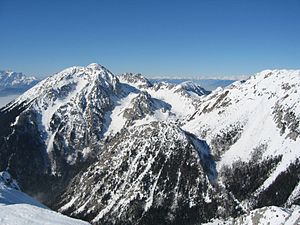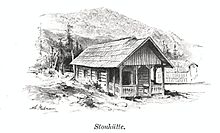High chair
| High chair (stol) | ||
|---|---|---|
|
High chair seen from the Weinasch from the northwest |
||
| height |
2237 m above sea level A. 2236.4 m. i. J. |
|
| location | Carinthia , Austria and Slovenia | |
| Mountains | Karawanken , Karawanken and Bacher Mountains | |
| Dominance | 22.1 km → Ryavina | |
| Notch height | 1022 m ↓ Seebergsattel | |
| Coordinates | 46 ° 26 '2 " N , 14 ° 10' 26" E | |
|
|
||
| rock | Dachstein Limestone | |
| Age of the rock | Norium - Rhaetium | |
| First ascent | August 17, 1794 by Franz von Hohenwart (first touristic ascent) | |
| particularities | Highest mountain in the Karawanken | |
|
High chair from the east ( Begunjščica ) |
||
|
High chair from the south ( Lake Bled ) |
||
The high chair (outdated Stou , Slovenian Stol ) is a mountain on the border between Carinthia ( Austria ) and Slovenia . With a height of 2237 m above sea level. A. it forms the highest elevation of the Karawanken . Its sharp northern slopes form an imposing head of the Carinthian Bärental valley .
Surname
The name "high chair" is based on popular belief; seen from the east, the shape of the mountain resembles a chair. The German name was introduced by Ludwig Jahne in the first Karawanken guide in 1882 at the "suggestion of several Carinthian friends of the Alps". It is a translation of the Slovenian “Stol”. Previously, the mountain name was given in German as “Stou”, which phonetically corresponds to the Slovenian “Stol”.
Location and surroundings
The high chair rises in the municipal areas of Feistritz im Rosental on the Austrian side and Žirovnica on the Slovenian side. The border runs over the summit along the Drau - Save -Wasserscheide and is marked there with the boundary stone XXV / 135 . Immediately in front of the main summit to the south is the Kleiner Stuhl ( 2172 m ). The high chair made of Dachstein lime breaks off to the north with a 500 meter high wall into the large Hochstuhlkar . The north wall is heavily furrowed, brittle and divided into countless gullies and gorges. To the south, the mountain has comparatively less steep meadow slopes.
To the east, the high chair drops into the smaller Kar Melo . This is limited in the north by the sharp rock peaks Marthaspitze ( 2116 m ), Klagenfurter Spitze ( 2104 m ) and the Edelweißspitzen ( 1995 m ), before the ridge of the Hochstuhl, which extends eastwards, descends into the Bielschitzasattel ( 1840 m ). This connects the high chair massif with that of the Wertatscha ( 2180 m ). The ridge stretches to the west from the Hochstuhl summit over the Ludwig-Jahne-Kopf ( 2018 m ), the Weinasch ( 2104 m ) and the Mali Vrh ( 2017 m ) before it descends more strongly into the Bärensattel ( 1698 m ). This forms the transition to the Bärentaler Kotschna ( 1944 m ).
Tourist development
The first tourist ascent was made on August 17, 1794 by the Austrian natural scientist Franz von Hohenwart at the invitation of Sigmund Zois von Edelstein . Led by the Wocheiner Bergsteiger Legat from Jauerburg (Javornik), he climbed the Bärensattel from the west side to the summit. A detailed ascent report was published in Articles on the Natural History, Agriculture and Topography of the Duchy of Carniola in 1838 . The first ascent of the north face was made about 100 years later by Karl Greenitz and Roderich Kaltenbrunner on September 9, 1906.
Alpine shelters were opened at the end of the 19th century for climbing the high chair. It all started with the Austrian Tourist Club , which took over the building of the mining administration of the Krainische Industriegesellschaft ( 1181 m ) on a terrace below the scree fields south of the Hochstuhl summit and opened it as an alpine refuge in 1883 under the name Valvasor-Schutzhaus . On August 14, 1886, the Klagenfürt section of the German and Austrian Alpine Club opened the Stouhütte ( 960 m ) in Bärental - an adapted hunter's house - as a base for tours on the high chair from the north side.
On September 16, 1906, the Stouhütte was replaced in its function by the new and better located Klagenfurter Hütte ( 1664 m ) near the Bielschitzasattel, on the southern slopes of the Kosiak . The Slovenian Alpine Association also opened the Preschern Hut in the immediate vicinity of the summit on the Kleiner Stuhl on July 31, 1910 . During the Second World War, all three bases were burned down by partisans. Only after two decades could they be rebuilt and reopened.
Climbs
The Austrian normal route leads from the Klagenfurter Hütte ( 1664 m ) south through the Bielschitzakar to the Bielschitzasattel ( 1840 m ). From there then - losing a few meters in altitude - into the Slovenian Hochstuhlkar Melo, keeping to the right through wide fields of scree into the Stuhlsattel and on to the summit. The cirque can also be reached from the south from the Završnica valley. In winter, ski tourers usually climb from the Bodental over the Wertatschasattel ( 1845 m ), past the Bielschitza to the intersection with the summer trail coming from the Klagenfurter Hütte. The Slovenian normal route leads from the Valvasor refuge directly over the southern slopes to the summit.
The popular high chair via ferrata ( B / C ), which is around 500 meters in altitude, also leads through the northern flank of the mountain . It was created from 1966 to 1967 by the Klagenfurt branch of the Austrian Mountain Rescue Service under the direction of Fritz Havranek, and in 2000 the lower part was slightly extended. Climbing tours are mostly only done on the Klagenfurt peak ( 2104 m ) and on the Edelweiss peaks ( 1995 m ), as the north face of the high chair proves to be too brittle.
literature
- Hans M. Tuschar: Karawanken Alpine Club Leader . Ed .: Austrian Alpine Association . Bergverlag Rother , Munich 1990, ISBN 978-3-7633-1262-7 .
- Manfred Posch : The magic kingdom of Karawanken. The most beautiful tours . Kärntner Druckerei- und Verlagsgesellschaft mbH, Klagenfurt 1997, ISBN 3-85391-143-9 .
swell
- ^ Federal Office for Metrology and Surveying Austria: Austrian Map online (Austrian map 1: 50,000) .
- ^ Heinz-Dieter Pohl : Mountain names in Austria
- ↑ Ludwig Jahne : Guide through the Karawanken . Lechner, Vienna 1882, p. 46.
- ^ Franz von Hohenwart : Contributions to the natural history, agriculture and topography of the Duchy of Krain , Laibach 1838, pp. 39–41.





